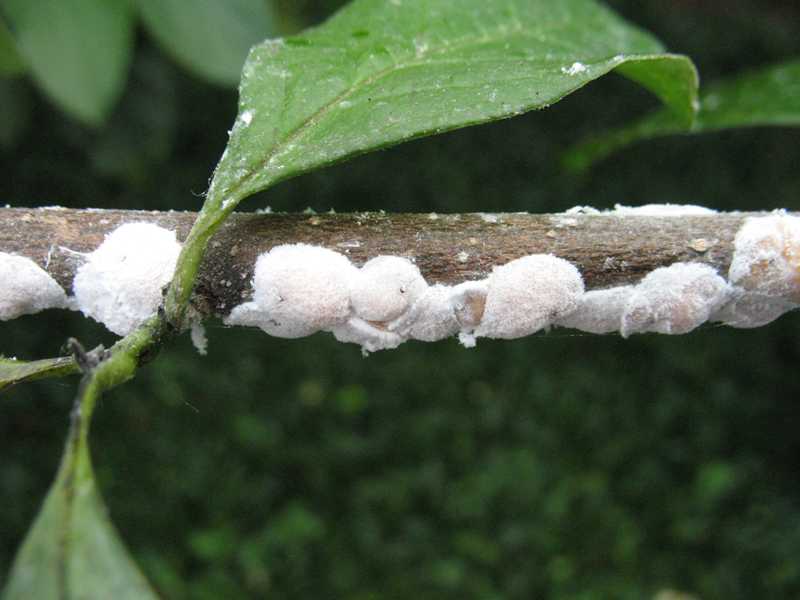Introduction
Magnolia scale (Neolecanium cornuparvum) is an insect that feeds exclusively on magnolia plants. It is one of the largest scale insects in the United States. The insect feeds by extracting plant liquids from the host’s leaves. The persistent feeding may result in extensive foliar dieback, and eventually, plant mortality.
Distribution & Habitat
Magnolia scale is indigeous to North America. It is widely distributed across the eastern United States.
Hosts
Magnolia scale feeds on magnolia plants. The insect is most partial to cucumbertree magnolia, lily magnolia, saucer magnolia, and star magnolia. It attacks other varieties of magnolia, albeit with less frequency.
Description
The nymphs are dark gray, with a reddish brown ridge that trails along the middle of the back. The adults differentiate in size and appearance. The males are miniscule, resembling small flies. The females are much larger, measuring about 12 mm in diameter. The nymphs vary from pink-orange to brown in coloration, and have a smooth, elliptical body. When mature, the females will often cover themselves in a white, waxy powder.
Life Cycle
Magnolia scale produces one generation per year. The immature nymphs overwinter on older twigs. In spring, they resume activity, continuing to feed until they mature. The nymphs reach maturity from late July to early August. Once mature, the nymphs mate. Soon thereafter, the males expire. The females navigate to nearby hosts, where they proceed to deposit eggs on the underside of leaves. This period of egg laying occurs from late August to early September. After laying their eggs, the females die. The eggs hatch from August to October, revealing masses of young nymphs, which wander for a short period before settling down on nearby foliage to feed. The nymphs feast on young twigs. As temperatures decline, the nymphs form a protective shell around themselves, and overwinter. The nymphs emerge from their shells the following spring, beginning the cycle anew.
Symptoms of Infection
As the nymphs feed, they excrete large volumes of a sticky substance referred to as honeydew. When infested, a plant’s foliage will often become laden with honeydew. The honeydew may become blackened from the growth of a sooty mold fungus. When abundant, the honeydew can smother foliage, and inhibit plant growth. Honeydew is a vital resource for several insects. A bevy of flies, bees, wasps, yellowjackets, and ants feed on this sticky substance. Ants can be particularly problematic for infested plants. Once the ants have detected the honeydew, they will ascend the infested plant in order to feast on it. To encourage the production of additional honeydew, the ants will safeguard the nymphs from predators. This helps to increase scale populations.
As the nymphs feed, they sap liquids from the host plant. Heavily infested trees can incur significant foliar damage, resulting in an overall reduction in growth. Seed production may also be hampered. Twig and branch dieback is a common symptom of infestation. Infested twigs will appear enlarged, and may turn purple.
Management
- Maintain plant vigor through sound cultural practices. Apply a layer of organic mulch around the base of magnolia plants to improve the soil quality, moderate the soil temperature, and retain soil moisture.
- Ensure that plants are sufficiently watered, especially during prolonged periods of drought.
- Horticultural oils may be utilized to smother the nymphs. Applications should begin in early spring, after the last frost has occurred, and prior to bud expansion.
- Insecticidal soaps are effective at eradicating the insects. Thorough coverage of infested foliage is required to ensure efficacy. Repeated applications may be necessary for dense populations.
- A variety of natural and synthetic insecticides are available for use to control the nymphs. Initial applications should be performed in late summer or early fall.
- Systemic insecticides can be applied as a drench treatment around the root zone of infested plants. The solution is absorbed into the roots, and transmitted throughout the plant, whereupon it is ingested by the nymphs. For the best result, treat the root zone in late winter, before the nymphs have become active.
- Magnolia scale has various natural enemies that help to minimize its populations. Some of the more notable enemies include lady beetles, predatory mites, and small parasitic wasps.
- When the nymphs are present, ants will tend to them. To prevent ants from accumulating on infested plants, place a band of sticky material around the trunk. Avoid placing any materials directly on the trunk, as they can have phytotoxic effects.
- Infested plants can be doused with water, which will dislodge the ants. Ants are also repelled by citrus and vinegar, which can be combined with water, and sprayed onto infested plants. The solution will mask the scent trails created by the ants, and act as a deterrent when honeydew is present.
- A mixture composed of boric acid powder, sugar, and water can be placed in several small containers, and distributed throughout the environment. The sugar will lure the ants to the tainted solution, which they will consume, and deliver to their queen. Once the queen has been exposed to the solution, she will expire, and the colony will collapse.
- Ant stakes or containerized bait may be placed on the ground to lure ants away from infested plants.
Photo courtesy of Missouri Botanical Garden


